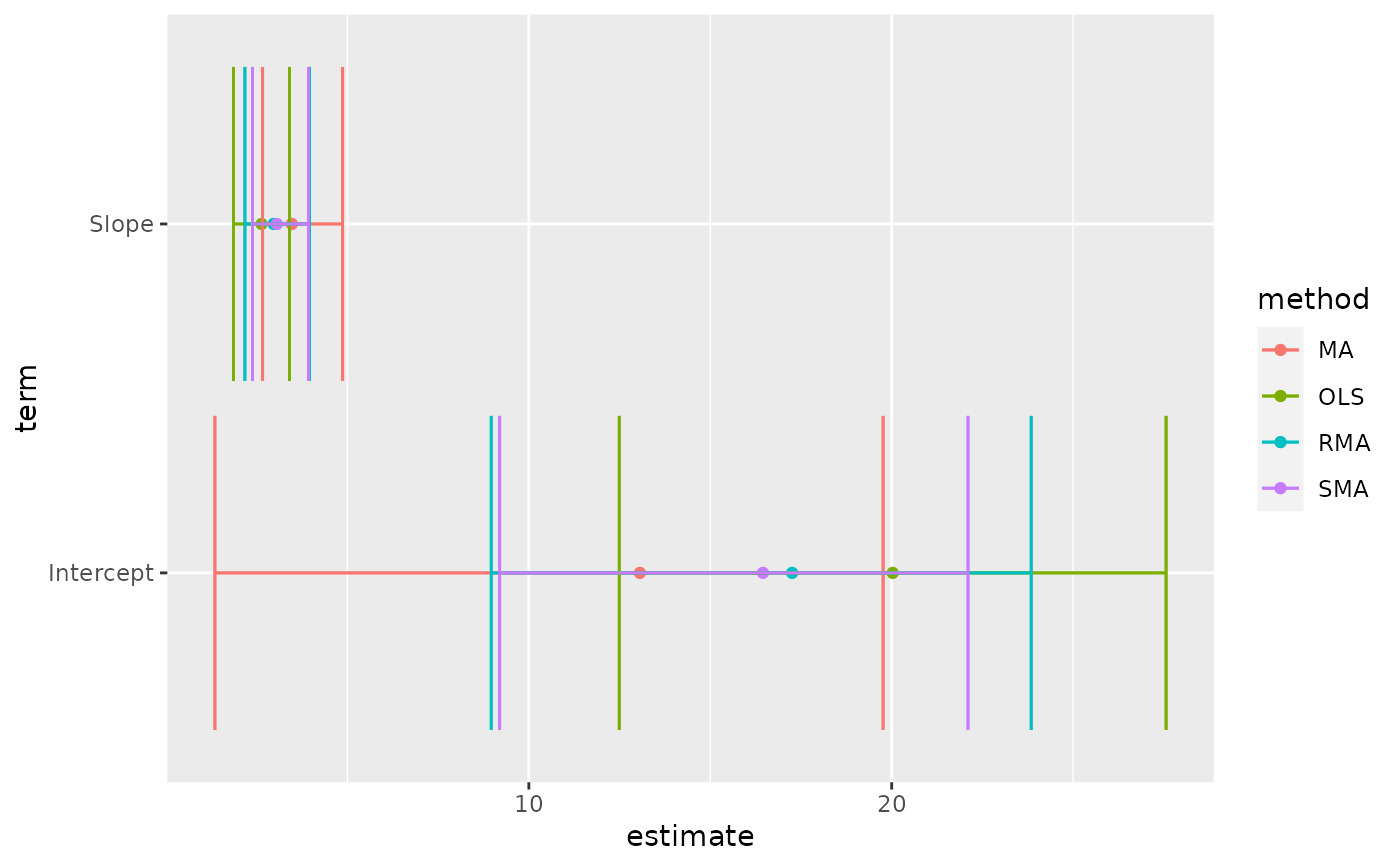Tidy 總結了有關模型組件的信息。模型組件可能是回歸中的單個項、單個假設、聚類或類。 tidy 所認為的模型組件的確切含義因模型而異,但通常是不言而喻的。如果模型具有多種不同類型的組件,您將需要指定要返回哪些組件。
參數
- x
-
lmodel2::lmodel2()返回的lmodel2對象。 - ...
-
附加參數。不曾用過。僅需要匹配通用簽名。注意:拚寫錯誤的參數將被吸收到
...中,並被忽略。如果拚寫錯誤的參數有默認值,則將使用默認值。例如,如果您傳遞conf.lvel = 0.9,所有計算將使用conf.level = 0.95進行。這裏有兩個異常:
細節
lmodel2 中始終隻有兩個術語:"Intercept" 和 "Slope" 。這些通過四種方法計算:OLS(普通最小二乘法)、MA(長軸)、SMA(標準長軸)和 RMA(範圍長軸)。
返回的 p 值為 one-tailed,通過排列測試計算得出。使用排列檢驗是因為分布假設可能無效。更多信息可以在 vignette("mod2user", package = "lmodel2") 中找到。
也可以看看
其他 lmodel2 整理器:glance.lmodel2()
值
帶有列的 tibble::tibble():
- conf.high
-
估計置信區間的上限。
- conf.low
-
估計置信區間的下限。
- estimate
-
回歸項的估計值。
- p.value
-
與觀察到的統計量相關的兩側 p 值。
- term
-
回歸項的名稱。
- method
-
OLS/MA/SMA/RMA
例子
# load libraries for models and data
library(lmodel2)
data(mod2ex2)
Ex2.res <- lmodel2(Prey ~ Predators, data = mod2ex2, "relative", "relative", 99)
Ex2.res
#>
#> Model II regression
#>
#> Call: lmodel2(formula = Prey ~ Predators, data = mod2ex2, range.y
#> = "relative", range.x = "relative", nperm = 99)
#>
#> n = 20 r = 0.8600787 r-square = 0.7397354
#> Parametric P-values: 2-tailed = 1.161748e-06 1-tailed = 5.808741e-07
#> Angle between the two OLS regression lines = 5.106227 degrees
#>
#> Permutation tests of OLS, MA, RMA slopes: 1-tailed, tail corresponding to sign
#> A permutation test of r is equivalent to a permutation test of the OLS slope
#> P-perm for SMA = NA because the SMA slope cannot be tested
#>
#> Regression results
#> Method Intercept Slope Angle (degrees) P-perm (1-tailed)
#> 1 OLS 20.02675 2.631527 69.19283 0.01
#> 2 MA 13.05968 3.465907 73.90584 0.01
#> 3 SMA 16.45205 3.059635 71.90073 NA
#> 4 RMA 17.25651 2.963292 71.35239 0.01
#>
#> Confidence intervals
#> Method 2.5%-Intercept 97.5%-Intercept 2.5%-Slope 97.5%-Slope
#> 1 OLS 12.490993 27.56251 1.858578 3.404476
#> 2 MA 1.347422 19.76310 2.663101 4.868572
#> 3 SMA 9.195287 22.10353 2.382810 3.928708
#> 4 RMA 8.962997 23.84493 2.174260 3.956527
#>
#> Eigenvalues: 269.8212 6.418234
#>
#> H statistic used for computing C.I. of MA: 0.006120651
#>
# summarize model fit with tidiers + visualization
tidy(Ex2.res)
#> # A tibble: 8 × 6
#> method term estimate conf.low conf.high p.value
#> <chr> <chr> <dbl> <dbl> <dbl> <dbl>
#> 1 MA Intercept 13.1 1.35 19.8 0.01
#> 2 MA Slope 3.47 2.66 4.87 0.01
#> 3 OLS Intercept 20.0 12.5 27.6 0.01
#> 4 OLS Slope 2.63 1.86 3.40 0.01
#> 5 RMA Intercept 17.3 8.96 23.8 0.01
#> 6 RMA Slope 2.96 2.17 3.96 0.01
#> 7 SMA Intercept 16.5 9.20 22.1 NA
#> 8 SMA Slope 3.06 2.38 3.93 NA
glance(Ex2.res)
#> # A tibble: 1 × 5
#> r.squared theta p.value H nobs
#> <dbl> <dbl> <dbl> <dbl> <int>
#> 1 0.740 5.11 0.00000116 0.00612 20
# this allows coefficient plots with ggplot2
library(ggplot2)
ggplot(tidy(Ex2.res), aes(estimate, term, color = method)) +
geom_point() +
geom_errorbarh(aes(xmin = conf.low, xmax = conf.high)) +
geom_errorbarh(aes(xmin = conf.low, xmax = conf.high))

相關用法
- R broom tidy.lmRob 整理 a(n) lmRob 對象
- R broom tidy.lm 整理 a(n) lm 對象
- R broom tidy.lm.beta 整理 a(n) lm.beta 對象
- R broom tidy.lavaan 整理一個熔岩物體
- R broom tidy.lsmobj 整理 a(n) lsmobj 對象
- R broom tidy.robustbase.glmrob 整理 a(n) glmrob 對象
- R broom tidy.acf 整理 a(n) acf 對象
- R broom tidy.robustbase.lmrob 整理 a(n) lmrob 對象
- R broom tidy.biglm 整理 a(n) biglm 對象
- R broom tidy.garch 整理 a(n) garch 對象
- R broom tidy.rq 整理 a(n) rq 對象
- R broom tidy.kmeans 整理 a(n) kmeans 對象
- R broom tidy.betamfx 整理 a(n) betamfx 對象
- R broom tidy.anova 整理 a(n) anova 對象
- R broom tidy.btergm 整理 a(n) btergm 對象
- R broom tidy.cv.glmnet 整理 a(n) cv.glmnet 對象
- R broom tidy.roc 整理 a(n) roc 對象
- R broom tidy.poLCA 整理 a(n) poLCA 對象
- R broom tidy.emmGrid 整理 a(n) emmGrid 對象
- R broom tidy.Kendall 整理 a(n) Kendall 對象
- R broom tidy.survreg 整理 a(n) survreg 對象
- R broom tidy.ergm 整理 a(n) ergm 對象
- R broom tidy.pairwise.htest 整理 a(n)pairwise.htest 對象
- R broom tidy.coeftest 整理 a(n) coeftest 對象
- R broom tidy.polr 整理 a(n) polr 對象
注:本文由純淨天空篩選整理自等大神的英文原創作品 Tidy a(n) lmodel2 object。非經特殊聲明,原始代碼版權歸原作者所有,本譯文未經允許或授權,請勿轉載或複製。
